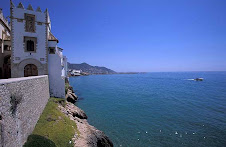Sitges has 17 sand beaches. Four of them are in the East: the first one called Les Botigues at the beginning of the coast, next to the beachs of Castelldefels and the other three are following the coast of Garraf (Road C-31). There are eleven urban beaches and two in the west. These last two have difficult access. The last one (Playa del Muerto) is the gay beach.
The main beach in May, in the background the church of Sant Bartomeu I Santa Tecla
All the eastern and urban beaches have access facilities, flags indicating the state of the sea and most of them have quality diplomas and blue flags awarded by the European Union.
Modern Sitges, preserving important references from the Middle Age and the old farmers’ and fishermen’s town, offers visitors an impressive architectural and cultural heritage, the result of initiatives by artists, cultural energizers and patrons like Santiago Rusiñol, Ramon Casas, Miquel Utrillo or Charles Deering.
Thanks to them, Sitges was a reference point for writers, musicians and other intellectuals and became an important center for disseminating Modernism and the "Americanos", who, after returning with their "fortune" from their American adventure, commissioned large mansions from Modernist and Noucentista (post Art Nouveau) architects.
The museums, guided tours or walks around the old quarter allow us to visit and relive this important legacy. This creative impetus has made it possible to create new projects like The International Barcelona-Sitges Vintage Car Rally, the International Film Festival, the International Jazz Festival or the Summer Concerts Series.
For over 100 years, Sitges has been celebrating nonstop –between the months of February and March, according to the liturgical calendar- Carnestoltes, or Carnival.
The festivities begin on Dijous Gras, or Fatty Thursday, with the arribo, King Carnestoltes’ spectacular arrival. From the moment this character appears until the burial of the sardine – late afternoon on Ash Wednesday – you could well say that life in Sitges moves to a new beat.
Here there is even room for youngsters to step into the limelight with children’s ruas, or Carnival parades, on Sunday and Tuesday afternoon.
Folk dances and xatonades (traditional local salad served with assorted omelets) are also characteristic carnival elements. The two most important moments are the Rua de la Disbauxa, or the Debauchery Parade, on Sunday night and the Rua de l‘Extermini, or Extermination Parade, on Tuesday night. Some forty-odd floats with more than 2.000 participants leave a jam-packed Sitges completely breathless.
Beach & Culture in Sitges
Gastronomy of Sitges
Xató is Sitges' most typical dish. It appeared in the press for the first time in a report about Maundy Thursday published in the local newspaper Eco de Sitges the 16th of February of 1896. The report refers to a meal that three days before had gathered together a selected group of Catalan artists and intellectuals, Santiago Rusiñol, Miquel Utrillo, Gaietà Buigas and others. The name “xató” comes from an expression pronounced years before by Canudas, a member of the Rusiñol's group.
The main ingredients of xató are escarole salad, cod, tuna, anchovies and arbequine and black olives. However, the essence of the dish is its sauce, made with scalded chillies, toasted almonds, garlic, olive oil, salt, vinegar and hot peppers. The complete xató meal consists of some different omelettes or fricandó (a typical Catalan hot meal) and as a dessert coca de llardons (typical Catalan cake, made from pork scratchings). And to drink a good bottle of Penedès black wine.
Apart from the xató, there are some other typical dishes from Sitgetan cuisine, which turn fish into an unequivocal sign of identity. Rice in the Sitgetan way, stewed sepia with potatoes and all-i-oli (typical Catalan garlic sauce), bull de tonyina (typical sailors´ dish made with tuna fish), fideuà (typical sailors´ dish similar to paella, but with noodles and seafood) or stuffed peppers with cod. Such variety guarantees the extraordinary richness and singularity of our gastronomy.
As for drinks, malvasia is the most representative one. We are talking about an oloroso and delicate liquor wine, excellent for desserts. The name “malvasia” comes from the Peloponnesian port Monembasía. In Sitges, the Hospital Sant Joan Baptista continues producing and marketing malvasia according to the traditional method and for charity. The annual production is approximately of 4.000 bottles (produced by the vines owned by the Hospital). The Sitgetan malvasia is produced and matured in the wine cellars of the Hospital.
General Info About Sitges
Sitges (Latin: Blanca Subur), Catalonia, Spain is a small city about 40 kilometers south west of Barcelona renowned worldwide for its Film Festival and Carnival. Between the hills and the sea, it is known for its much-frequented beaches, nightspots, and historical sites.
While the roots of Sitges' artsy reputation date back to the late 19th century, when Catalan painter Santiago Rusiňol took up residence there during the summer, the town really came into its own during the 1960s, when it was the only center for the counterculture on the mainland of Spain (then still under the dictatorship of Francisco Franco), and became known as a sort of "Ibiza in miniature".
Today, Sitges can be considered a dynamic cultural oasis, basing its economy on tourism and culture offering more than 4.500 hotel beds, half of them in four-star hotels. The firm commitment for quality infrastructures has converted Sitges into a first-class destination in terms of tourism of congresses, conferences, seminars and company meetings in the Mediterranean area.
It is also a gay tourist town - in July and August gay men and lesbians visit Sitges as "one of the most popular gay holiday spots in Europe". Sitges is very international. Almost 35% of the ca. 25.642 inhabitants are from the Netherlands, Great Britain, France and Scandinavia whose children can attend the international school.


